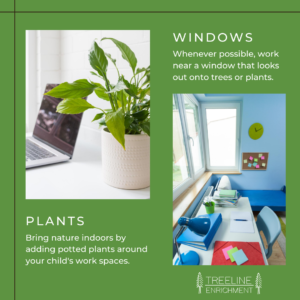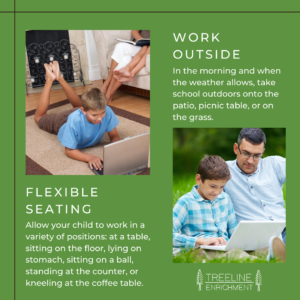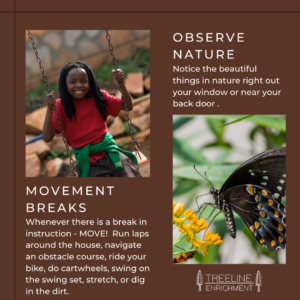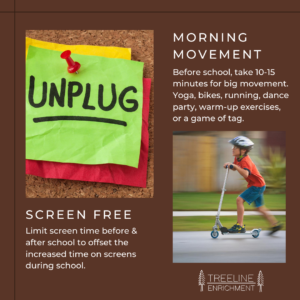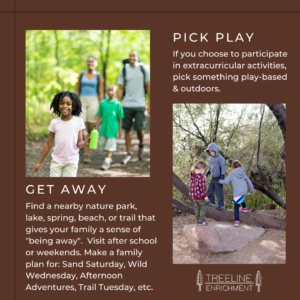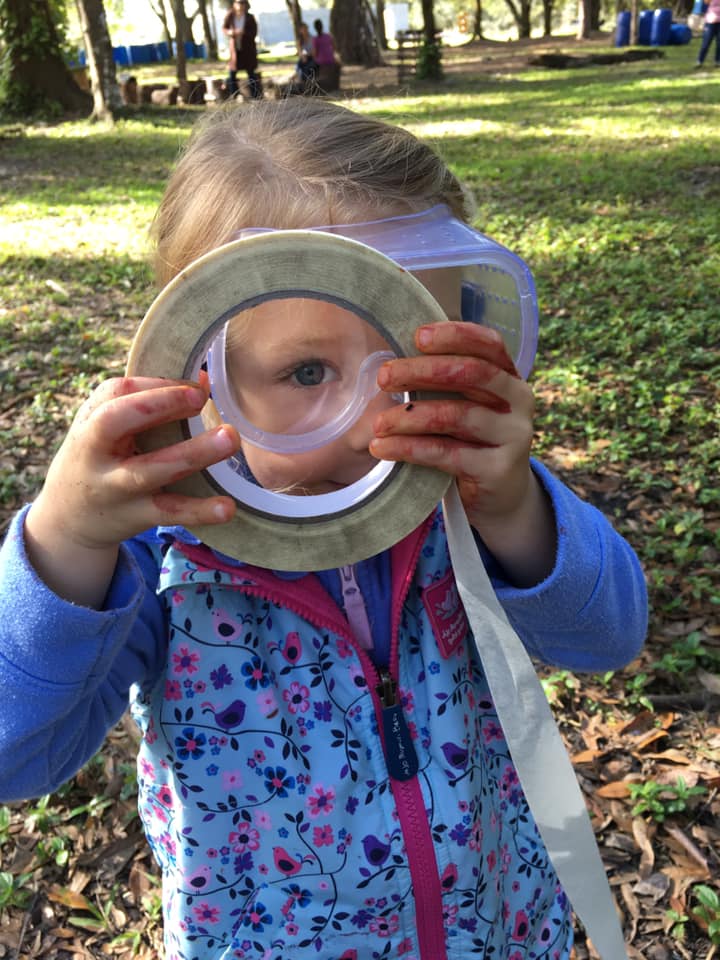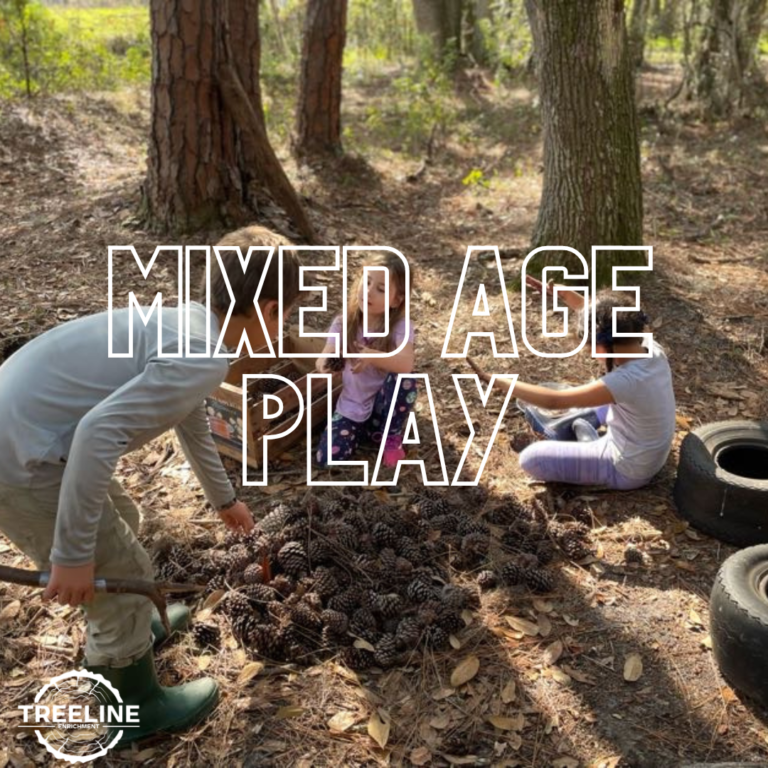12 Tips for E-Learning
Whew – you have started the school year! It has been months of roller coaster emotions, information (or lack thereof) and tough decisions. Now that you know a bit more about your child’s schedule, teachers, expectations, and school day, we put together 12 tips for e-learning to help you and your child make the most of this opportunity.
Respected author and children & nature advocate, Richard Louv states: “The more high tech our lives become, the more nature we need.”
“The more high tech our lives become, the more nature we need.” -Richard Louv
If your child is spending a bunch of time on the computer this school year, these tips will help your child:
- Balance screen time in their day
- Sustain attention
- Find calm
- Be ready to learn
- Stay active
- Regulate emotions
There are not just random tips → these 12 tips for e-learning are drawn from years of professional experience, rooted in research, and derived from professional theories. If you want to dig in deeper, check out Attention Restoration Theory, Biophilia Hypothesis, and Sensory Integration Theory.
Otherwise, let’s dive in:
1. Plants
If working outside is not feasible, bring the outside in by adding potted plants in and around your child’s work space. Did you know indoor plants can also help with air quality? Pay attention to the amount of sunlight in your child’s work area and look for plants that will thrive in high, moderate, or low light. I also like to look for plants labeled “tough as nails” –> they tend to survive even when I forget to water them. Or save some $ and take clippings of other plants you already have, set them in some water to help roots form, and then plant them!
2. Windows
Move your child’s desk or work areas near a window that looks out onto plants or trees. Simply seeing nature and embracing natural light can have a positive effect on your mood and help to give your eyes a break from the near-point screen. Learn more about how views of nature may also help healing and recovery.
3. Flexible Seating
Even in the traditional brick & motor building, kids are not sitting in a desk all day long. Younger children have multiple opportunities to move and change position, and even our older students rotate classrooms, get up for supplies, and work around the room. You have even more opportunities to provide flexible seating at home. Flexible seating allows your child to engage different muscle groups, improve attention, and stay a little more active.
Here are some ideas to help you get started:
- Kneel (1-leg kneel or 2-leg kneel) at the coffee table
- Stand at the counter
- Lay on your stomach on the floor – use a clipboard under your paper
- Sit on a ball chair
- Put 3 puffs of air in a beach ball and sit on top if it
- Sit on the floor (long leg, criss cross, or wide leg). Place your computer / tablet on top of a stack of books.
- Order a wobble chair for 360 degree wiggle movement at a desk.
Find the natural transitions in your child’s school day to offer flexible seating options. Young children may need pictures to help them decide. You can offer a written list of options for older students. Encourage your child to stay in the same general area throughout each learning section and change to a new seat during those transition points.
4. Work Outside
Don’t forget about your backyard, patio, garage, or front porch as viable work spaces. Yes it’s hot and humid right now, but tap into the “slightly” cooler mornings for a little school outside. A patio table and a strategically positioned umbrella can make for a great work space with the added benefits of fresh air, natural light, and views of nature. And soon enough the weather will cool down and you can do a lot of your school work outside. Click here for some tips to keep your kids comfortable outside even in the Florida heat.
*Be sure to check your internet connection outdoors before you jump into class.
5. Crunchy Snacks
Help your child stay alert by offering crunchy snacks. This “heavy work” can be organizing and help springboard energy for more e-learning. Snack ideas might include:
- Sliced apples
- Celery sticks
- Carrot sticks
- Sliced cucumbers
- Cashews
- Almonds
- Whole wheat crackers
- Popcorn
- Cheese crisps
- Sweet potato chips
- Homemade trailmix
- Sugar snap peas
- Sliced peppers
At home you also have the opportunity to let your child quietly chew gum during their work time! Gum chewing can be super helpful for some kids (and adults). It’s worth a try. Pick sugar-free gum and provide guidelines for gum use, such as mouth closed, one piece at a time, must be disposed in the trash, and cannot be a distraction to work or instruction.
6. Smells
Use natural scents from your kitchen and garden to help energize or calm. To energize, try citrus or peppermint. To calm, try lavender. Fresh materials / ingredients also help to support nature connection but if you don’t have access right now, you can look for these scents other places:
- Scratch & sniff
- Scented stickers
- Scented markers
- Essential oils
- Scented candles
7. Movement Breaks
Kids (and adults) need lots of movement in their days for their health and wellness. Our kids are made to move and sitting in front of a computer screen for 5-7 hours is totally contrary to what they bodies need. We might not be able to change those expectations, but we can give our kids movement breaks every-chance-they-get.
Whenever there is a transition, instructional break, lunch break, or work break – have your child spend 3-15 minutes MOVING! Race around the house, blast some music and have a dance party, set up & complete an obstacle course, do jumping jacks, bounce on a trampoline, do cartwheels across the lawn, swing or climb on your swing set, work on digging a hole to the other side of the earth, or do some sun salutations!
8. Observe Nature
Feeling mentally fatigued? Head outside and observe some amazing things in nature. Ants working, the shapes of clouds, the way wind moves the tree branches, the rain splattering on the walkway, bees collecting nectar, water flowing off of leaves, butterflies fluttering between flowers, squirrels chasing each other, or birds flying. When we take time to find the wonders of nature, our brain gets a chance to restore it’s attention capacity and your child (and you) may find a renewed ability to focus and learn.
9. Screen Free
Since your child’s work day includes lots of screen time, limit screen time before and after school to help offset this new school routine. It can be hard to set the boundaries and you may get some resistance for your kids, but after a few days you will most likely discover the complaining decreases and the creativity increases.
10. Morning Movement
Prioritize getting movement before the school day begins. This extra movement will help to ready their brain for learning, feel comfortable in their own bodies, promote healthy activity levels, improve their mood, help them attend to their school activities.
Turn it into a memory making moment by joining your child in their morning movement. Race scooters down the driveway, put on your favorite playlist and dance around the house, let your child lead you in a yoga routine with Yoga Pretzels (by Tara Guber), walk / run the dog around the neighborhood, play a game of tag, or one of my kid’s favorite – play a round of the Yoga Spinner game (by ThinkFun).
11. Get Away
When school is not in session, make plans to “get away” outdoors. This does not have to mean an overnight or long trip away. Instead find a place relatively nearby that gives your family the sense of “being away”. For my family, we head to the beach, a state park, or one of the many Florida springs. By “getting away” you are helping to change the scenery, decrease the feeling of being “stuck” at home, and helping to improve your overall mental health.
It’s also important to remember these “away” moments can occur any afternoon or weekend. I love alliterations, so here are some of my favorite schedule tips for you.
- Afternoon Adventures (go Geocaching around town)
- Trail Tuesday (hike after school)
- Wild Wednesday (explore a nature preserve)
- Fishing Friday (grab your pole and head to a lake)
- Forest Friday (pack a picnic and head to a State Park)
- Float Friday (borrow or rent a kayak on one of our many lakes)
- Sand Saturday (head to the beach & build sand castles)
- Surf Sunday (grab a body board and head to the beach)
Do you have another alliteration to add to this list? Comment below and I’ll add it.
12. Pick Play
If you choose to enroll your child in extracurricular activities or enrichment programs, pick something outdoors (for the many mental & physical health benefits) and play-focused (to help your child socially and emotionally). To learn more (and why), listen to this 15 minute and super informative TED talk by the renowned researcher & psychologist, Peter Gray.
If you want suggestions, send me a message and I’ll help you find an option for your children.
BONUS TIP: Allow Fidgets
Fidgets can help keep hands busy and minds engaged. A fidget can be anything small, in hand, that does not distract from learning. Some OT favorites might include:
- Squish / stress balls
- Rubbing fingers along the rough or soft side of velcro
- Fidget spinners (cubes make noise, so error on the spinners)
- Silly putty or small ball of play dough (can be inside plastic bag too)
- Click and snap bendable “snakes”
- Sliding a marble inside a mesh closed pocket
- Wikki stix
You can make your own fidgets or buy a box of fidgets here. The first 3 people (local to Lakeland or Plant City FL) that send me a message about this post will get a special pack of fidgets from me for your e-schooling use.
When you provide fidgets, it’s important to set guidelines such as: 1 fidget at a time, cannot distract from work or learning, and use of a fidget as a tool not a toy.
⭐Let me Know ⭐
Comment below to let me know which of these 12 tips for e-learning you plan to use. PLUS send a message with a photo if these ideas in action and I’ll highlight your e-learning strategies on our social media accounts. Do you need more ideas for this school year? Comment below and we can brainstorm together.
This post contains Amazon affiliate links. When you shop using these links you are helping us (at no additional cost to you) provide quality materials and resources for our nature based occupational therapy and nature play programs.


